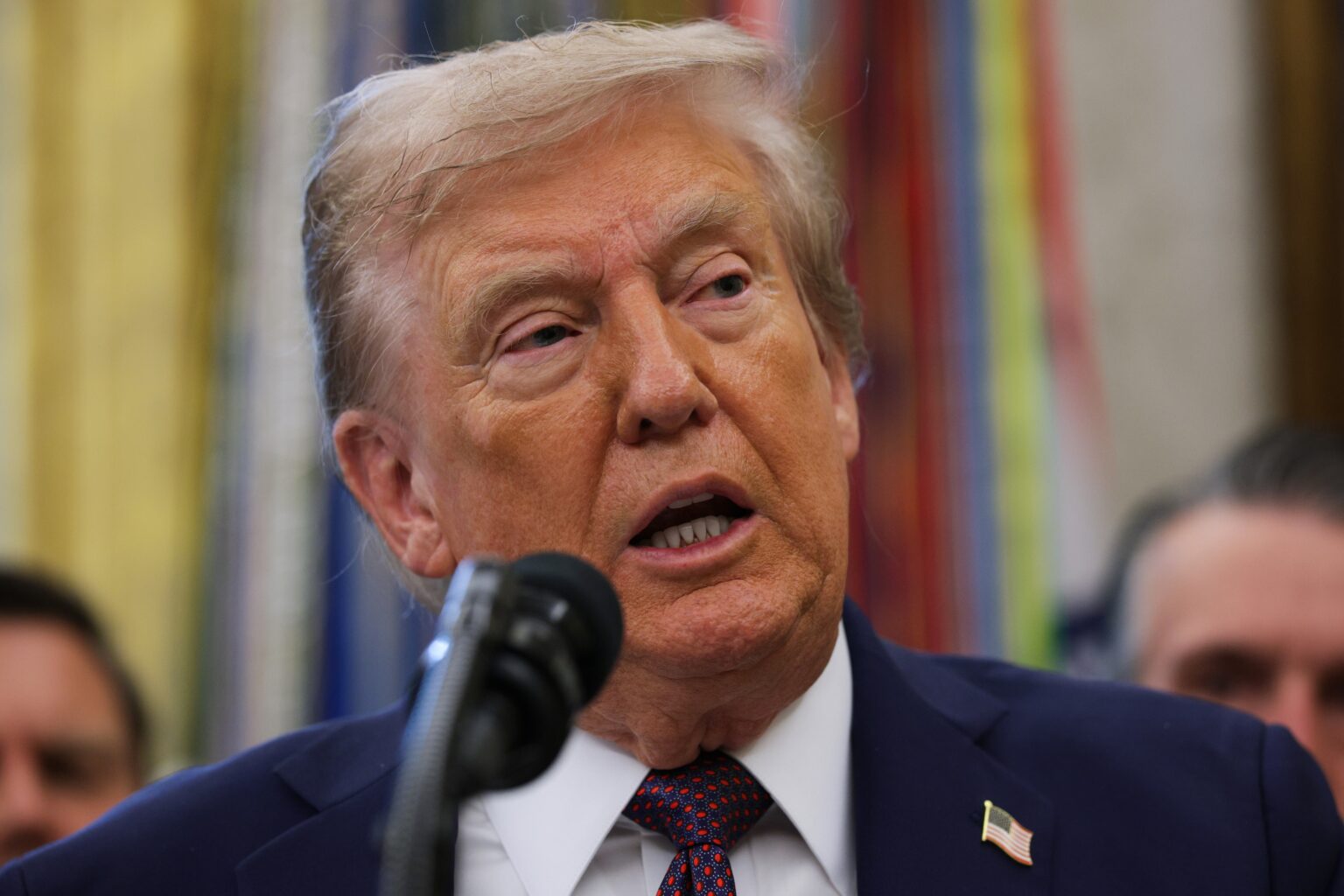President Donald Trump has outlined a dramatic proposal to reshape the American health-care system, suggesting that federal funds currently routed through insurance companies should instead be distributed directly to individuals. Speaking publicly as the United States entered the 39th day of the longest government shutdown in its history, Trump presented the plan as a way to give Americans greater control over their own health care while reducing reliance on what he described as inefficient and costly insurance intermediaries.
In posts on his social media platform, Truth Social, the 79-year-old president criticized the Affordable Care Act, commonly known as Obamacare, labeling it “the worst health care anywhere in the world.” He argued that the government should stop providing funding to insurers and instead empower citizens to purchase their own coverage, stating that this would allow individuals not only to access better health care but also to retain surplus funds. In his words, the goal is to “take from the big, bad insurance companies, give it to the people, and terminate per dollar spent.”
While Trump’s announcement has captured headlines, the specifics of the plan remain largely undefined. Key questions—including who would qualify for the payments, how much each person would receive, and the logistics of distribution—have not been answered. The proposal also raises uncertainties about how it would interact with existing private health-care options, employer-based coverage, or the ACA marketplaces.
Background: The ACA and Federal Health-Care Subsidies
The Affordable Care Act, signed into law in 2010, expanded access to health care for millions of Americans. It allows individuals under the age of 26 to remain on their parents’ insurance plans and prohibits insurers from denying coverage based on pre-existing conditions. The ACA also provides a marketplace through which individuals can purchase health plans, and it includes subsidies to help lower- and middle-income Americans afford premiums.
Under the current system, subsidies are paid directly to insurers, helping offset the cost of premiums for eligible individuals. Eligibility is determined primarily by household income relative to the federal poverty line, with subsidies available for those earning between 100 and 400 percent of that benchmark. These payments help maintain enrollment in ACA-compliant plans and stabilize the insurance market by keeping premiums affordable.
The enhanced subsidies, expanded under recent federal legislation, are set to expire at the end of the year. Without renewal or adjustment, premiums for many Americans are expected to increase significantly in 2026. This expiration has added urgency to the ongoing negotiations over government funding and the shutdown.
The Proposal’s Key Elements
Trump’s plan focuses on several central objectives:
-
Direct Payments to Individuals – By giving Americans money directly, the plan seeks to allow them to choose the health coverage they believe best suits their needs, rather than having options determined largely by insurance providers.
-
Reducing the Role of Insurance Companies – The proposal frames insurers as intermediaries that add cost without improving outcomes. By bypassing them, the administration argues that the government can deliver funds more efficiently to the public.
-
Fiscal Responsibility and Cost Control – Trump claims that redirecting funds directly to individuals would reduce government waste and encourage more efficient spending on health care.
-
Critique of Existing Health-Care Systems – The president has repeatedly described the ACA as ineffective and costly, arguing that current arrangements benefit insurance companies more than patients.
Political Context and Reactions
The proposal comes amid a protracted government shutdown, the longest in U.S. history, which began on October 1. The shutdown has created significant disruption in federal services and heightened the stakes for resolving the dispute over ACA subsidies. Democrats have proposed a one-year extension of the subsidies to stabilize coverage and ease the impact on Americans relying on ACA plans, but Republicans have rejected this approach, citing concerns about ongoing funding for insurers.
Democratic leaders have expressed skepticism about whether the president would follow through on direct payments, particularly given previous controversies over the administration’s management of federal programs. Some critics note that Trump’s administration has previously restricted assistance programs, including SNAP food aid, despite court orders to maintain funding.
Republicans argue that the current system disproportionately benefits insurance companies while delivering limited improvements in health outcomes. Senator Lindsey Graham of South Carolina emphasized that continuing to funnel taxpayer dollars to insurers “to get an inferior outcome” is unacceptable. Meanwhile, Senate Minority Leader Chuck Schumer proposed a bipartisan approach that would negotiate subsidies and include them in a continuing resolution to reopen the government, but Republicans rejected this plan, describing it as a non-starter.
Potential Benefits and Challenges
Supporters of Trump’s plan argue that direct payments could empower individuals, giving them greater autonomy in managing their health care. They contend that this could foster competition among providers, encourage innovation, and reduce administrative overhead associated with insurance companies.
However, critics highlight significant uncertainties. The adequacy of the payments is unclear, and there is no guarantee that individuals could use them to obtain comprehensive coverage. Low-income Americans, those with chronic conditions, and others with high medical needs might be left vulnerable if payment amounts fall short of market premiums. Additionally, the logistics of administering direct payments on a large scale could be complex, requiring new oversight and verification systems.
Insurance market analysts warn that removing federal subsidies from insurers could destabilize the marketplace. Premiums might rise, some insurers could withdraw from less profitable markets, and coverage options could become more limited. The impact on state Medicaid programs and other public health initiatives remains uncertain, as these systems are closely tied to federal funding streams and ACA provisions.
Broader Implications
If implemented, the plan would represent a fundamental shift in the philosophy of American health-care policy. The current system relies on insurance intermediaries to pool risk and manage costs, whereas the proposed model emphasizes individual responsibility and choice. This approach could reshape the landscape of employer-based coverage, ACA marketplace plans, and Medicaid expansion programs.
From a fiscal perspective, Trump’s administration argues that direct payments would be more efficient and cost-effective. However, without clear parameters for payment amounts and eligibility, it is difficult to assess whether the plan would reduce overall spending or simply shift costs from insurers to individuals and the government in different ways.
Outlook and Next Steps
At present, the proposal remains a concept rather than formal legislation. The White House has indicated that any legislative initiative would follow the resolution of the government shutdown. Lawmakers must first reach agreement on a funding plan to reopen federal operations before debating substantive health-care changes.
As the shutdown continues, millions of Americans remain uncertain about the stability of their health coverage and the availability of subsidies. The expiration of enhanced ACA payments at year-end adds additional pressure on Congress to act swiftly. Whether Trump’s plan can navigate the legislative process, garner support, and be implemented effectively is a central question for the next several months.
The proposal underscores a larger debate in U.S. health-care policy: the tension between government-managed insurance programs and individual choice, between cost control and access, and between short-term fiscal goals and long-term health outcomes. While supporters see it as a bold step toward empowering consumers, critics worry about the potential for coverage gaps, market instability, and adverse consequences for the most vulnerable populations.
In the weeks ahead, Congress, the administration, and stakeholders across the health-care system will closely examine the feasibility, costs, and implications of direct payments. The outcome will not only shape policy for millions of Americans but could also redefine the role of insurance companies, the structure of subsidies, and the future of the ACA itself.

Emily Johnson is a critically acclaimed essayist and novelist known for her thought-provoking works centered on feminism, women’s rights, and modern relationships. Born and raised in Portland, Oregon, Emily grew up with a deep love of books, often spending her afternoons at her local library. She went on to study literature and gender studies at UCLA, where she became deeply involved in activism and began publishing essays in campus journals. Her debut essay collection, Voices Unbound, struck a chord with readers nationwide for its fearless exploration of gender dynamics, identity, and the challenges faced by women in contemporary society. Emily later transitioned into fiction, writing novels that balance compelling storytelling with social commentary. Her protagonists are often strong, multidimensional women navigating love, ambition, and the struggles of everyday life, making her a favorite among readers who crave authentic, relatable narratives. Critics praise her ability to merge personal intimacy with universal themes. Off the page, Emily is an advocate for women in publishing, leading workshops that encourage young female writers to embrace their voices. She lives in Seattle with her partner and two rescue cats, where she continues to write, teach, and inspire a new generation of storytellers.







